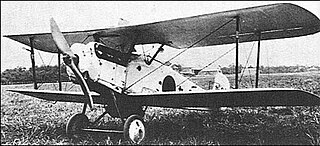
The Mitsubishi B1M was a Japanese torpedo bomber of the 1920s, also known as the Navy Type 13 Carrier-Borne Attack Aircraft. It was designed and built by Mitsubishi and used in combat against China. The aircraft was used by the air services of the Imperial Japanese Navy and Imperial Japanese Army.

The Mitsubishi B2M was a Japanese carrier-based torpedo bomber of the 1920s and 1930s. It was built by Mitsubishi to a design by Blackburn Aircraft of Britain and was operated by the Imperial Japanese Navy.

The Fiat CR.1 was an Italian biplane fighter aircraft of the 1920s. Of wood-and-fabric construction, it was designed by Celestino Rosatelli, from whom it gained the 'CR' designation. Its most distinctive feature was that the lower wings were longer than the upper ones.
The PZL.48 Lampart (leopard) was a Polish heavy fighter-bomber design, that remained only a project, owing to the outbreak of World War II.
The Letov Š-16 was a Czechoslovak single-engined, two-seat biplane bomber. It was designed by Alois Šmolík at Letov Kbely. The Š-16 first flew in 1926.

The Mitsubishi 1MF was a Japanese carrier fighter aircraft of the 1920s. Designed for the Mitsubishi Aircraft Company by the British aircraft designer Herbert Smith, the 1MF, also known as the Navy Type 10 Carrier Fighter was operated by the Imperial Japanese Navy from 1923 to 1930.

The Mitsubishi 2MR was a Japanese carrier-based reconnaissance aircraft of the 1920s, also known as the Navy Type 10 Carrier Reconnaissance Aircraft or the C1M in the Navy's short designation scheme. Designed for Mitsubishi by the British aircraft designer Herbert Smith, the 2MR was used by the Imperial Japanese Navy through the 1920s and 1930s.

The Letord Let.5 was probably the most numerous of a family of 3-seat reconnaissance bombers, designed and built in France from 1916, originally to an A3 specification from the STAé.

The Mitsubishi Army Type 92 Reconnaissance Aircraft (九二式偵察機) was a Japanese short-range reconnaissance aircraft of the 1930s designed by Mitsubishi for the Imperial Japanese Army Air Force. A total of 230 were built, serving between 1933 and 1936. A parasol monoplane, the Type 92 was the first military aircraft powered by an engine both designed and manufactured in Japan to enter service.
The Gabardini G.8 was an Italian single-seat aircraft produced in both fighter and trainer versions by Gabardini in 1923.
The Bellanger-Denhaut 22 was a twin-engined bomber/reconnaissance flying boat designed by François Denhaut the technical director for seaplanes for the car manufacturer Bellanger.
The Blériot 118 was a 1920s French amphibian flying-boat fighter designed by Léon Kirste, only one was built and it was not ordered into production.

The Bernard 82 was a French single-engined long-range monoplane bomber designed and built by Société des Avions Bernard. Only two prototypes were built and the type did not enter production.
The Borel-Odier Bo-T was a French twin-engined float biplane designed by Borel but built by Antoine Odier for the French Navy.

The Mitsubishi 2MB2 or Experimental Washi-type Light Bomber was a prototype Japanese single-engined biplane light bomber of the 1920s. A single example was built for the Imperial Japanese Army, but no production followed.

The Wibault 8 or Wib 8 Simoun (Simoon) was a tandem seat, parasol wing fighter aircraft designed and built in France to a 1925 specification which was later withdrawn; only one Wib 8 was completed.

The ANF Les Mureaux 180 was a prototype French fighter aircraft of the 1930s. designed and built by Les Ateliers de Construction du Nord de la France et des Mureaux. It was a single-engined, two-seat, gull wing monoplane, only one was built and the programme was abandoned as obsolete.
The Blériot 73 was a large First World War French heavy night bomber designed and built by Blériot to the BN3 specification. Only a single prototype was built, which crashed on landing from its first flight, killing the pilot. The Blériot 74, Blériot 75 and Blériot 76, respectively, a heavy bomber / airliner, airliner and heavy bomber, directly evolved mfrom the Blériot 71 / Blériot 73 bombers.

The Borel-Boccaccio Type 3000, also known as Borel C2, was a two-seat fighter designed and built in France to a 1918 C2 specification.

The Hiro H3H1 or Navy Type 90-1 Flying boat was a Japanese flying boat bomber built in 1931. It was the first large all-metal aircraft built in Japan. Only one was completed.













